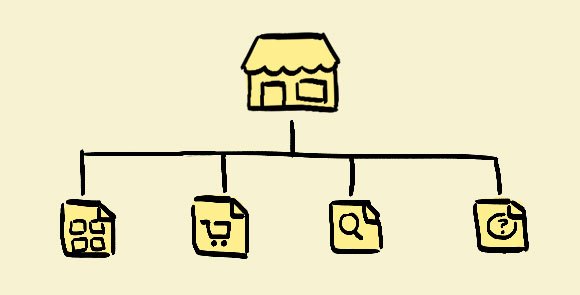
When Sei-Wook and I first started Barrel, we took on all kinds of projects. We designed logos for nonprofits, we built websites on Textpattern CMS, and we designed three-panel brochures. For some clients, we took designs from their team and coded the HTML. For others, we supplied the PSD files and let their developers handle it. We were also industry agnostic. We worked with clean tech companies, academic institutions, brick and mortar stores, and fashion brands. I remember one time, we happened to launch a website for a boutique investment bank and a nail salon in the same week, so we wrote a single blog post announcing the launches. The investment bank client joked that it was probably the only time that their brand would ever be mentioned in the same article as a nail salon.
We believed that being flexible in this way was a strength and a way to capture all kinds of business that came our way. We could say yes to a beverage company looking for a marketing website and a B2B company looking for a dashboard app in the same week. It also kept things interesting. We could rotate our team through different types of projects and make sure people never got tired of doing the same thing over and over again. The most important thing, we reasoned, was that we got to combine design, technology, and strategy and deliver quality work to our clients, no matter what they wanted or which industry they worked in. Sounds great, right?
The Value of Expertise
As the size of our projects have grown in both scope and budgets, we’ve found our generalist approach to be problematic. We’ve essentially positioned ourselves as a jack of all trades, master of none. Clients who engage us in bigger projects want more depth in our offerings: a deeper UX process, analytics that prove our work has led to successful outcomes, stronger understanding of their industries, and more thorough documentation. They want experts who’ve gone deep in a particular area and can deliver, with certainty, a smooth and effective offering.
The lack of depth has been a hindrance to our business development efforts. A retail company who approaches us about re-doing their e-commerce website because they like the look of our designs is disappointed to learn that we haven’t done many integrations with point-of-sale systems. A nonprofit looking to launch a national campaign likes that we know WordPress but is uncomfortable that we don’t have a fully fleshed-out branding process that can provide them with a visual identity system for all their print materials and TV spots. When we say, “It shouldn’t be a problem for us to handle,” it’s rarely reassuring. They find someone who’s gone deep in the area they’re most worried about. We lament and say that’s too bad, they would’ve had a kick-ass website.
We no longer want to find ourselves in these types of situations. We want to be confident about our expertise and to clearly outline for clients what we can do and what we won’t do. This means making some hard decisions and setting the boundaries that will define our expertise.
Saying Goodbye
We’re working on a long-term strategy to define and firmly establish our expertise. In the meantime, we’re taking steps to signal our intentions to existing clients. We’ve examined our client roster, analyzed the relationship (in both numbers and fit), and have started making hard decisions on which client relationships we’ll continue to cultivate and which we’ll end. In looking at our roster and finances, we quickly learned that the 80/20 rule–20% of your customers generate 80% of your revenues–rang true for us, with our top 30 clients generating 79% of our revenues for the first 6 months of 2013. And just as importantly, we saw that the bottom 55 clients in terms of billings generated just 10% of revenues. While many of the work for these 55 clients included minor updates to their existing sites or small one-off enhancements, we’ve seen the toll that these projects take on our team. Some requests are unexpected and urgent, causing strain on our scheduling. Part of the solution is to put clients on sizable retainers. The other part is to realize that we can no longer properly service certain clients for what they’re willing to pay and help them find a new firm.
This is a difficult challenge in that we’ll have to transition out many clients who’ve placed their trust in us over the years, helping us get to where we are today. But as hard as these conversations may be, we know it’s in the best interests of both parties. We can focus on building our expertise, and our clients can hire a new firm whose capabilities and pricing match their needs. Our goal is to be proactive in this process and to provide strong transition options for our clients, understanding that change will be difficult for them.
Next Steps
We’ve assembled an internal team to help brainstorm, discuss, and formulate a plan to narrow our focus and develop our positioning. We have some initial ideas about which types of projects and industries may work for us, but we’re going to ask ourselves some tough questions and find out what it is that we really want to do. We also expect this process to give us a clear idea of what we want to be known for and the things we’ll have to do establish ourselves as true experts. We’re incredibly excited, and we’ll keep you posted on our progress.
Resources
There are two books worth mentioning that have really helped me think more deeply about narrowing our focus, better positioning ourselves, and becoming experts:
- Positioning for Professionals: How Professional Knowledge Firms Can Differentiate Their Way to Success by Tim Williams
- The Win Without Pitching Manifesto by Blair Enns
Both books are excellent reads and have great insights on business development and strategy. I only wish I had come across these books a few years earlier, but I’m very happy I got to read them back-to-back.
Illustration by Andrea Horne





Pingback: Expert Focus, Sleeve-Roll and Disrupt
Pingback: short term loans canada
Pingback: direct payday loan online canada lender
Pingback: drugrehabcentershotline.com substance abuse counselor